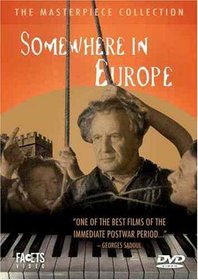| Actors: Artúr Somlay, Miklós Gábor, Zsuzsa Bánki, György Bárdy, Laci Horváth Director: Géza von Radványi Creators: Barnabás Hegyi, Géza von Radványi, Félix Máriássy, Béla Balázs, Judit Fejér Genres: Indie & Art House, Drama, Music Video & Concerts Sub-Genres: Indie & Art House, Drama, Music Video & Concerts Studio: Facets Format: DVD - Black and White,Full Screen - Subtitled DVD Release Date: 03/28/2006 Original Release Date: 01/01/1947 Theatrical Release Date: 01/01/1947 Release Year: 2006 Run Time: 1hr 40min Screens: Black and White,Full Screen Number of Discs: 1 SwapaDVD Credits: 1 Total Copies: 0 Members Wishing: 3 MPAA Rating: NR (Not Rated) Languages: Hungarian Subtitles: English |
Search - Somewhere in Europe on DVD
  | Somewhere in Europe Actors: Artúr Somlay, Miklós Gábor, Zsuzsa Bánki, György Bárdy, Laci Horváth Director: Géza von Radványi Genres: Indie & Art House, Drama, Music Video & Concerts NR 2006 1hr 40min SOMEWHERE IN EUROPE is the first major achievement of postwar Hungarian cinema as well as a key film in the history of neorealist cinema. Directed by Geza Radvanyi and co-written by legendary film critic and scholar Bela B... more » |
Larger Image |
Movie DetailsSimilar Movies
|
Movie ReviewsSomewhere in the East Alex Udvary | chicago, il United States | 07/15/2007 (4 out of 5 stars) "The title "Somewhere in Europe (Valahol Europanban)" reminds me of the title of a Nicolae Marginaeanu film, "Somewhere in the East". There is a vaguness to each of them. These stories transcend beyond the story of their countries, respectively Hungary and Romania. The topics are so universal; that of the aftermath of destruction left after WW2 and the resistance to Communism in Eastern Europe, that they speak for the entire region. But the vaguness of those titles actually speak volumes.
Most people have a very limited and narrow view when they think about the destruction WW2 caused. Cinematically, at least, this has been proven true. Films generally only deal with a few countries when dealing with this subject. The most famous of them is probably Italy. The entire neo-realism movement was a direct result of the destruction the war caused and gave us such classics as "Open City", "The Bicycle Thief" and "Germany Year Zero". France is another country. And the topic has even been dealt with in recent times as was the case in the brilliant Andre Techine film "Strayed" and Jean-Paul Rappeanu's light-hearted "Bon Voyage". Poland and England are the other remaining countries. In the case of Poland, once again the topic did come up recently in Roman Polanski's "The Pianist" But rarely is attention given to countries which were on the east side of the Berlin Wall, except in the case of Poland. That makes "Somewhere in Europe" a rarity. I cannot think of another Hungarian film which directly deals with the aftermath of WW2 and Hungary's resistance to fascism . There have of course been Hungarian films which dealt with war. Take a look at a quartet of films directed by Miklos Jansco, "The Red and the White", "Silence and Cry", "The Round Up" and "Hungarian Rhapsody", but these weren't about WW2. "Somewhere in Europe" made in 1947 has a deep rich history and is quite important to Hungarian cinema. This film, along with "The Red and the White", represent something so large that they take on multiple meanings. The bad part is research is required on the part of the viewer. The films become stronger if you understand the history of the country. "Somewhere in Europe" was influenced by Italian neo-realism. It has a cinema verite style to it. Natural lighting is used, it is shot on real-locations, non-professional actors are used, but the film still manages to get some stylized moments in. In short the film follows 25 orphans who are left with nothing after the orphan shelter has been bombed. Wanted by authories, beause they are reported as being a "menace" they seek refuge with an elderly conductor, who is also in hiding. The man and the children form a friendship, as he teaches them the importance of freedom and how all people are equal. Now keep in mind by 1947 the Soviets had control over the "eastern bloc", so this film's message of all people are equal and it is the government's job to take care of the people could have borderlined on a socialist, or its far left cousin, communist rhetoric. Does that mean the film is anti-fascist and pro-communist? Well it is clearly anti-fascist. Pro-communist though? I'm not sure. The movie argues Hungary does not want any outside forces coming in hurting its people. Could this have been attempt by the filmmaker, Geza von Radvanyi, to make a social comment on the current force occuping Hungary, the communist? The film has wonderful heart-felt moments, many of the children are cute and our sympathy goes out to them. But this film didn't seem pushy to me. I realize it is pushing a social message forward but I wasn't overwhelmed by it. I accepted it as a sad slice of life, a reality of the times. I suppose this was enhanced by the locations and the non-actors. One has to apologize if a review tends to get too political or become a history lesson, but, as I said, some films are not merely about what is on the surface, the encompass the history and politics of their country so closely it is hard to talk about the film and not mention something about the country. But isn't that the great thing about movies? They show us and teach us about cultures we may not have otherwise known about. Bottom-line: Geza von Radvanyi's look at the destruction WW2 left on Hungary ranks as one of the most important films in Hungarian cinema. A movie that does more than tell a story, it is history on screen." |






